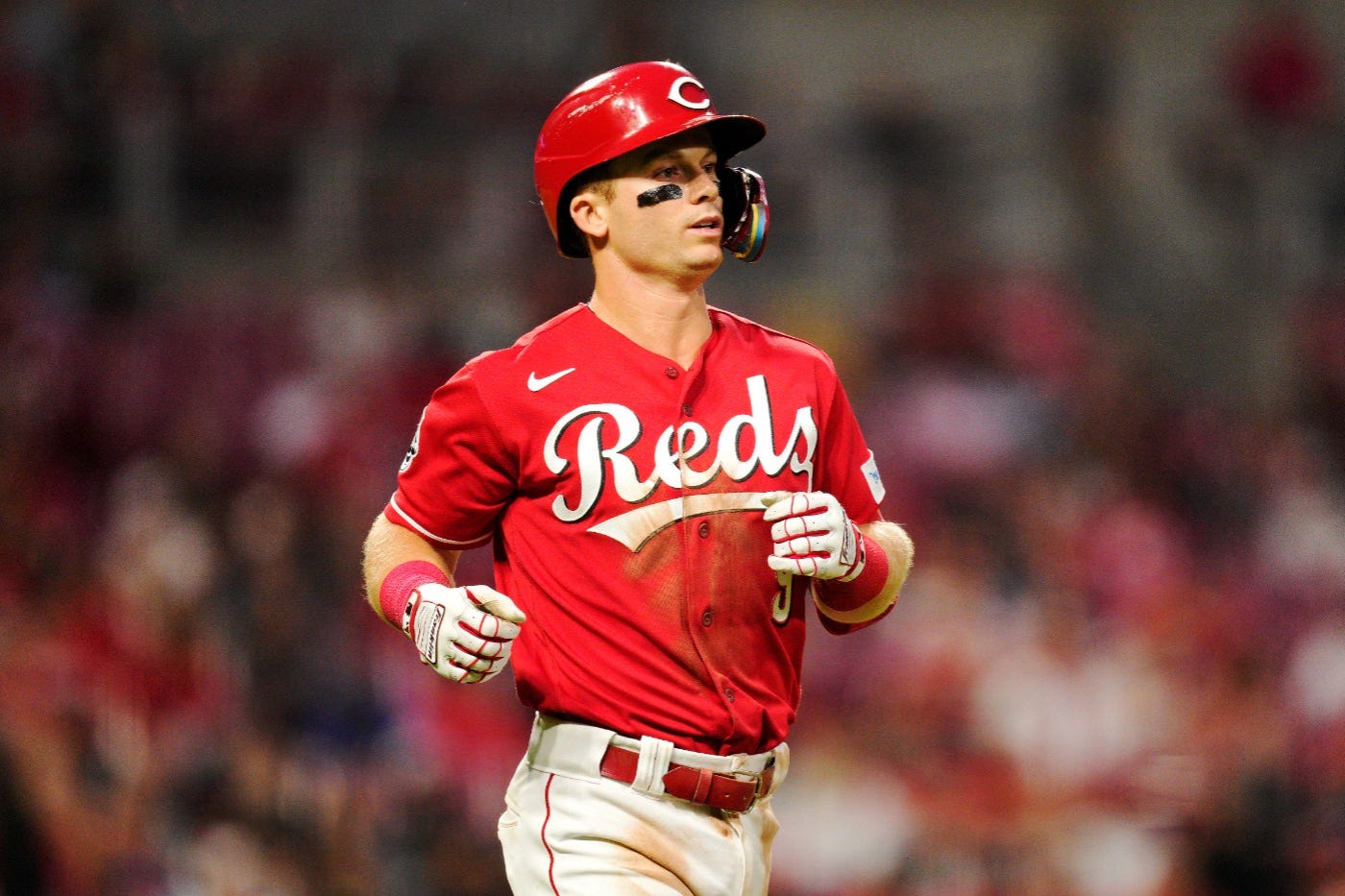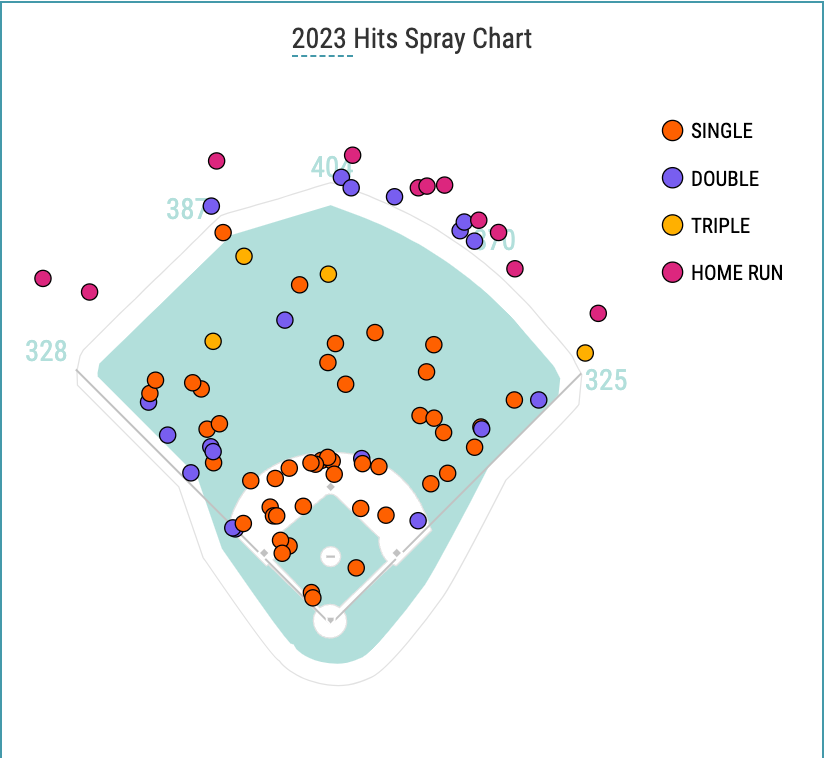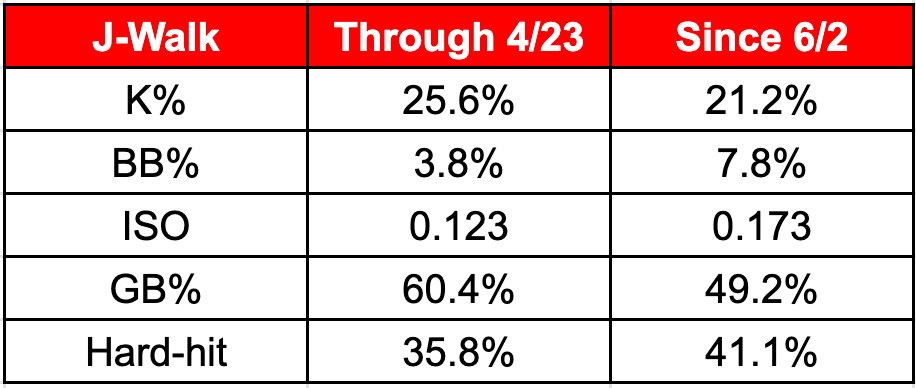Rookie Report: Matt McLain, Brett Baty, Jordan Walker
Another check-in on some rookie bats
Nothing crazy today - just a few updates on some rookies who I either haven’t written about yet (McLain) or who have faded from the greater fantasy baseball conversation (Baty, Walker).
Unlike last week’s small sample crew (linked below) these three rookies have more of a track record to work with. As we get closer to the end of the season I’ll do another write-up on the top Rookie of the Year contenders.
As always, reach out on Twitter with questions, @toomuchtuma.
I’ve also recently set up a Discord for Substack and Patreon subscribers. If you’re interested in expanding these conversations with others, please feel free to join!
Small Sample Rookie Hitter Analysis
The goal of this piece is to take a look under the hood at what several rookie hitters are doing in small samples. Of course, it should be noted that young players are volatile in fantasy baseball - we have less data on them and therefore don’t always know the true baseline. It’s part of what makes the recent Josh Lowe downturn so disappointing. Things …
Now let’s dive into today’s post!
Note stats are entering Monday’s action.
Matt McLain, 2B/SS, Reds
As everyone is well aware, the Reds are loaded with infield prospects. Several of their young position players are moving around on a day-to-day basis, McLain included.
Luckily for the 23-year-old, he’s hit the ground running and seems to be cementing himself as a core part of this Cincinnati rebuild that looks close to completion.
Through 65 games, and nearly 300 plate appearances, he’s hitting .305/.375/.530 with 11 homers and 8 stolen bases. It adds up to a 138 wRC+. Only Edouard Julien, Luke Raley, and Corbin Caroll have a higher mark among qualified rookies.
That isn’t to say there aren’t warning signs. McLain is striking out 27.7% of the time while carrying a .405 BABIP.
Let’s start with his plate discipline (this should always be our starting point when evaluating young bats). McLain’s chase rate is a little above average (27.2%), but that’s primarily because he’s swinging so infrequently overall.
If he had the PAs to qualify within the entire player pool, McLain’s 41.1 swing% would be the 18th lowest. His 59.2% swing rate inside the zone would be tied for 10th lowest. The cat-and-mouse game of swing/don’t swing is such a delicate balance for big league hitters. Normally I’d prefer for McLain to be a bit more aggressive, especially in the zone, but clearly things are working for him right now. It’s an adjustment he can use when needed.
As for his batted ball results, the .405 BABIP suggests regression, though he’s got a 40% ground ball rate and 91st percentile sprint speed, so high BABIPs will likely be part of his early-career profile. It’s also worth noting he hits the ball all over. Look at this spray chart:
The comparison isn’t perfect, but McLain’s skill set is very reminiscent of Bo Bichette, who has been a premium fantasy player since his debut. Does McLain have that sort of upside?
This isn’t where I expected to land when I began writing him up, and I haven’t even gotten to some of the good stuff.
McLain’s barrel rate is in the 72nd percentile of MLB players. He can drive the ball; this isn’t some slap-hitting speedster. While his hard-hit and exit velo numbers don’t POP, they’re firmly “pink” on Baseball Savant. Again, he has the ability to do damage upon making contact.
On top of all this, he plays in Cincinnati.
Here are Baseball Savant’s Park Factor grades (rolling 3-year averages):
Coors Field 111
Fenway Park 109
Great American Ballpark 108
It’s my belief that the fantasy industry treats Coors as the lone “Tier 1” ballpark that enhances offensive production. It’s still the best, but the gap has shrunk in recent years (article on this topic is in the queue). Meanwhile, GABP is alone at the top for boosting homers specifically.
If there was ever a hitter who could benefit from playing in a true “little league park”, it’s one who has an above average barrel rate with modest power. That’s McLain.
I’m not saying he’s the next Bichette. But I’m not ready to put a cap on his upside just yet. McLain’s skill set is uniquely perfect for 5x5 leagues, in particular.
Brett Baty, 3B, Mets
I didn’t expect to need a cold shower after writing about McLain, but profiling these next two bats should do the trick.
Baty’s hard-hit numbers made him the star of Triple-A Opening Weekend this year. Unfortunately, the success hasn’t carried over to the majors.
Baty’s still hitting the ball hard (68th percentile, per Statcast, with a 113.7 maxEV), but his 51.4 GB% is one of the highest marks in the league. This is why, despite impacting the ball with some thump, Baty’s expected batting average is just .240 (and why his xSLG is just .384).
His 15.2% pulled fly ball rate is one of the lowest in the majors.
Additionally, Baty’s whiff and strikeout rates are in the bottom 20th percentiles.
It’s really hard to be an above average hitter with a GB% over 50%. Currently, just 16 players in the majors with at least the same number of PAs as Baty have achieved it.
Lifting the ball typically has more to do with pitch selection rather than a dramatic swing change, and Baty is still young enough to become a star.
Here’s where he’s making contact most frequently this year:
And here’s where he has the highest slugging percentage per ball-in-play:
It’s way easier said than done, and there’s a lot more that goes into hitting besides a simple heat map derived from Fangraphs, but it’s at least a visual to highlight Baty’s early-career struggles.
Jordan Walker, OF, Cardinals
Let’s start with the good. Walker has been better since being recalled from Triple-A at the beginning of June:
A .353 BABIP and a fortuitous hitting streak helped boost Walker’s early-season results. Being optioned to Triple-A was controversial at the time, and perhaps he would’ve improved just by continuing to play in the majors, but nonetheless he’s playing better now.
But just how good is “better?” Walker has a 115 wRC+ since being recalled. It’s solid. It just isn’t what everyone was hoping for back in spring training.
He’s still being quite aggressive, with a 34.6 O-swing% since June 2nd, which comes with a 51.7% swing rate overall. He’s whiffing at a bottom 20th percentile mark in the league during this time. Similar to Baty, the true cause of his high GB% could be from pitch selection rather than anything wrong fundamentally.
When Walker does lift the ball in the air he’s pulling it just 19.3% of the time. This needs to improve.
Raw strength isn’t a problem. J-Walk has a 93rd percentile maxEV this year. He’s also in the 83rd percentiles for average exit velocity and hard-hit rate.
And the reason to remain very much “in” on him (for rest-of-season, 2024 redraft, and for dynasty) is that he just turned 21 in May. That’s right - it’s easy to forget he debuted at 20 years old on Opening Day. Baty, meanwhile, turns 24 this fall. McLain turns 24 in a week.
By the middle/end of spring training this year, the idea of Walker making the Opening Day roster became a foregone conclusion. But as recently as January I was hearing from people at Baseball America that no elite-level prospect needed a full season in the minors more than Walker (mostly for the transition to the outfield, and his defense has been quite bad in the majors).
Still, back in January I never would’ve guessed Walker would be playing in the bigs so frequently and so soon. He is. He has been. And he’s been 15% better than league average for two months now. It’s clear what he needs to work on this offseason, and I very much plan to “buy the dip” should that opportunity present itself entering 2024.








Great stuff Brendan! So in a 10 team OPS keep 6 league, is Walker a hold? He’s currently taking up a bench spot bc I don’t want to drop him. My keepers will be Carrol, O’Neil Cruz, JRod, Elly, Austin Riley, and then one of Altuve, Torkleson, Walker, Glasnow, Kirby, or Gilbert. He’s probably #3 on that list of 4, possibly #2. Do you keep him and hope he figures it out for the stretch run or cut and use the spot for someone more productive and try and grab him for 2024? Thanks!